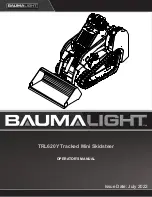
Check Before Operating
14
m–3742
1 Qt
Figure 6
1.
Filler Cap
Checking the Cooling System
The cooling system is filled with a 50/50 solution of
water and permanent ethylene glycol anti–freeze.
Check the level of coolant at the beginning of each
day, before starting the engine.
POTENTIAL HAZARD
•
Coolant is hot and pressurized.
WHAT CAN HAPPEN
•
Discharge of hot pressurized coolant can
cause severe burns.
HOW TO AVOID THE HAZARD
•
Do not remove the radiator cap when the
engine is hot. Always allow the engine to
cool at least 15 minutes or until the
radiator cap is cool enough to touch
without burning your hand before
removing it.
1.
Park the traction unit on a level surface, lower
the loader arms, and stop the engine. Remove
the key.
2.
Allow the engine to cool.
3.
Remove the radiator filler cap and check the
coolant level (Fig. 7). The coolant should be up
to filler neck.
4.
If coolant level is low, replenish the system.
IMPORTANT: Do not over fill the radiator.
5.
Replace the radiator filler cap, ensuring that it is
tightly sealed.
1
Figure 7
1.
Filler Cap
Removing Debris from the
Traction Unit
IMPORTANT: Operating the engine with a
blocked or plugged radiator will result in
engine damage from overheating.
1.
Park the traction unit on a level surface, lower
the loader arms, and stop the engine. Remove
the key.
2.
Check for debris in the air filter pre–cleaner.
Wipe away debris before each use and/or during
use, if required.
3.
Clean any debris from the engine with a brush or
blower before each use.
4.
From the front side of the radiator, either spray
the radiator with a hose or blow with compressed
air.
IMPORTANT: It is preferable to blow dirt
out, rather than washing it out. If water is
used, keep it away from electrical items.
Summary of Contents for 22302TE
Page 8: ...Safety 6 Slope Chart...





































